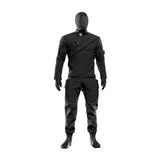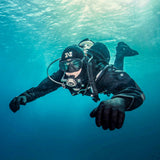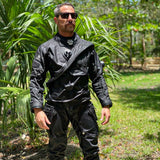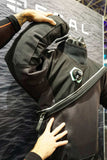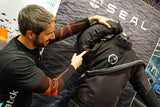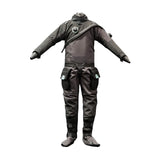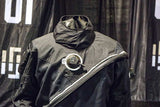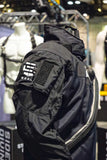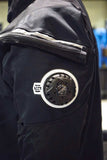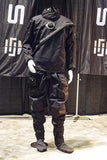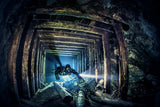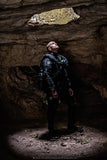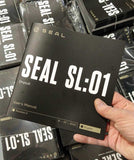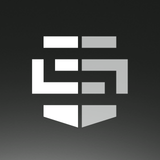Please note that you can't order drysuits directly from the online shop as they are made-to-measure. Please read the "How to Order" part below for more information.
How to Order
All SEAL drysuits are made-to-measure, meaning they will be perfectly tailor-made to your size and fitted with the options for your requirements. To order tailor-made drysuits from SEAL, please follow these steps:
- Visit the SEAL Configurator where you can configure all equipment options and enter your dimensions according to the displayed instructions. Please make sure you select “United Arab Emirates” as your country.
- Once you are done configuring, you will receive a PDF with a unique code which you need to sign and send to orders@titandiveshop.com. (Please note that there are additional 15% import cost of the price mentioned in the PDF.)
- We will send you an invoice with payment instructions and after the payment is done the SEAL factory will start with the production of your custom drysuit.
- Production time is around 6 weeks at the moment and we will contact you once we received your order.
Create your tailor-made drysuit now with the SEAL Configurator
Specification
| Suit type | Trilaminate drysuit, front entry |
| Main fabric | Nylon-polyester trilaminate with a sealed butyl layer, Ferguson-Polycom fabric 414g/m2 |
| Forearms and knee protection | Cut-proof and abrasion-proof Superfabric 600107 |
| Shoulder and top forearms protection | Cordura 500 dTEX |
| Stitch sealing | Chloroprene rubber tape with three layers of glue |
| Pockets | Two 3D pockets located on thighs |
| Weight | 2.7-2.9 kg depending on the configuration |
Available options
You can order the drysuit according to your individual requirements. The list of available options is as follows:
Part |
Standard |
Options |
| Drysuit shell | Nylon-polyester trilaminate with a sealed butyl layer | |
| Elbow and Knee pads | Superfabric | |
| Arm and pockets reinforcement | Cordura | |
| Zipper | Plastic TIZIP Masterseal 10 | Metal Dunat G2 CR/PU |
| Inflation valve | Si-Tech Skeleton | Apeks Low Profile |
| Exhaust valve | Si-Tech Gaude | Apeks Low Profile |
| Pockets | Two 3D pockets | |
| Neck seal | Latex | Silicone, Neoprene |
| Wrist seals | Latex | Silicone |
| Wrist/Cuff Rings | None | Si-Tech Antares |
| Feet protection | Trilaminate sock | Neoprene shoes |
The drysuit built for exploration
The SEAL SL:01 was created for one simple reason: there wasn't a drysuit on the market to meet the needs of all divers exploring caves and wrecks in remote areas and o en in extreme conditions.
There is a range of choice of very strong Kevlar-reinforced suits on the market as well as lightweight suits and some that provide great maneuverability, yet there was no drysuit which would ensure all of these features together.
To create the SEAL SL:01, we worked for several years with explorers who were supported by our XDEEP Exploration Support Program, built five generations of the suit, many different prototypes and spent many hours underwater. A key factor in the development process was that we hired designers with over 20 years of experience in building protection suits for the military and special forces.
The final result is outstanding. The SEAL SL:01 combines extreme reliability, low weight and freedom of movement unmatched by any drysuit on the market.
Features
Unique „Double-Shell Reinforcement”
Until now, almost all drysuits were made in the same way with varying thickness of fabric. To create a drysuit that is both robust and lightweight, we had to think outside of the box.
Through the years of exploration supported by the XDEEP Exploration Support Program, we noticed that 90% of drysuit fails happen in specific areas, such as exposed areas of the shoulder, lower parts of the leg and forearm – all the parts of the suits which are o en in close contact with rocks or parts of the wreck.
We all know that double-layer BCDs are far more resistant to puncture than those with single-layer construction. The two thinner layers of fabric are much stronger and more resistant to puncture than one thick layer. Instead of using heavy and rigid Cordura or Kevlar-reinforced fabric, we created the concept of Double-Shell Reinforcement.
The drysuit is made of very strong but lightweight and flexible trilaminate material which significantly improves the freedom of movement.
The exposed parts such as the shoulder area, upper forearms and pocket area are covered with the military-grade 500D Cordura, similar to the material used in the indestructible STEALTH 2.0.
Critical areas, such as the lower forearm and knee are reinforced with an even stronger material known as Superfabric, a resin-protected fabric that is almost impossible to cut, even when using a knife.
What is unique is that the base layer (trilaminate) and protection layers (Cordura and Superfabric) are not bound together. As both layers of the fabric can move over each other, the drysuit is extremely flexible and provides an unprecedented level of comfort and manoeuvrability.
A purely technical cut
Traditionally, drysuits have a very simple cut. It simplifies the made-to-measure production process which is convenient for the manufacturer, however, the cut is far from optimal. In some areas, there is o en too much material which can create air pockets, whilst in other parts there is too much restriction which causes a lack of flexibility.
From the very beginning of the Seal SL:01 project, we encouraged our designers to push the limits of what is possible in terms of freedom of movement with many ideas being inspired by the protection suits used by special forces.
As the project developed we not only used the expertise of our own designers but also consulted designers who manufacture the apparel used by climbers and those who design outdoor adventure garments.
The shape of the SL:01 makes it more expensive to manufacture, but once you wear the suit you will realize that it fits like no other suit on the market, 'like a glove'.
Easy entry zipper
Did we mention that SL:01 is influenced by the military suits used by the special forces? One of the critical features of the military drysuit is the ability to put them on in very restricted locations such as inside the armoured vehicles.
We had two goals in mind regarding the zipper; easy entry and avoiding contact with the harness. With the final placement of the zipper, we succeeded in both. The zipper location makes entry and exit from the suit effortless, which extends the zipper life by moving it away from contact with the shoulder straps of the harness.
3D pockets
The pocket construction has its own story and through the process we've refined the pocket position, design and construction at least seven times.
Different configurations and environments vary the requirements to the pocket size and location. Instead of copying the most common position of drysuit pockets, we created several prototypes and tested each in sidemount and backmount configuration, with both two and four cylinders and with the pockets both empty and full. Finally, we adjusted them to provide easy access whilst retaining the streamlined profile of the diver
The position is just one aspect, with usability and streamlined profile being equally important. The SL:01 pockets have a 3D construction which makes them flat and streamlined when empty, whilst at the same time being spacious enough to carry all the equipment necessary for exploration.
World's best materials and craftsmanship
Perfect cut and unique features would be nothing without quality.
Throughout the design phase we remained steadfast in terms of the quality benchmark we initially set. We tested many materials, checked each of them both in the field in the laboratory, whilst using them in our prototypes to ensure the fabrics match the quality we required to compliment the design.
Download the SEAL SL:01 brochure















